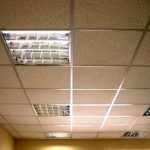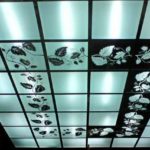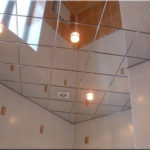The microclimate in the kitchen places high demands on the coatings. The options for finishing the ceiling in the kitchen are chosen based on the operating conditions, the price of materials, the cost of work and the chosen design.
Features of kitchen facilities
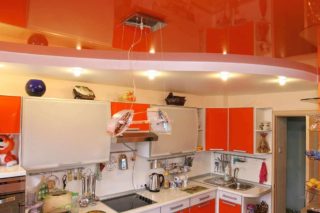
Kitchens that are constantly used for cooking become the source of several adverse factors affecting the finishing of the ceiling:
- soot and grease that accumulate on the ceiling, dust adheres to them, quickly changing the original appearance of the finish;
- high humidity causes the topcoat to peel off;
- sharp temperature changes affecting the durability of materials;
- hot air rising to the ceiling negatively affects the appearance.
The following requirements are imposed on finishing materials:
- resistance to dry cleaning of the surface;
- impossibility of damage by chemical additives in detergents;
- resistance to multiple temperature changes during the day;
- preservation of appearance when exposed to high temperatures;
- minimal absorption of odors;
- fire safety;
- ease of care.
Consideration should be given to the possibility of complete dismantling or replacement of the ceiling covering, as well as the maintainability of the selected solution in case of damage.
Plaster and putty
The method has become widespread due to the advantages:
- a layer of plaster does not take up useful space, the ceiling drops only 1–2 cm from the initial level;
- durability - the service life of a correctly applied composition is comparable to the time of using the building;
- small irregularities in the ceiling are eliminated on their own;
- resistance to negative operating conditions;
- easy renovation by painting method;
- compatibility with most styles of decoration;
- environmental friendliness and lack of allergies in the vast majority of people.
Not devoid of plaster and disadvantages:
- If a thick layer is required to level the ceiling, then the work is entrusted to professional finishers, which entails additional costs.
- The method is not very suitable for minor cosmetic repairs. During work, a large amount of dirt and dust is inevitable, which can damage other surfaces and furniture.
- The minimum period of work is 5-7 days, which are provided for by the application and finishing technology.
Overcoating times and layer thicknesses must be in accordance with the manufacturer's instructions. Violation of technology leads to cracking and destruction of the surface.
When buying materials, it is necessary to take into account the compatibility of primers, plasters and putties from different manufacturers.
For the finishing of plaster surfaces, paints for walls and ceilings are used. When choosing, take into account the possibility of wet cleaning.
Decorative plasters
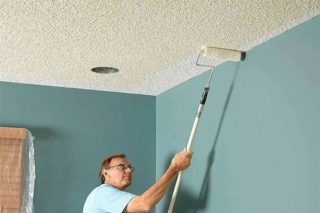
Decorating the kitchen ceiling with decorative plaster gives the room a unique look.
Distinguish between plasters:
- structural (fur coat or bark beetle) - when leveling the composition with spatulas, large granules of quartz sand create irregularities on the surface;
- Venetian, imitating the structure of a cut of natural stone;
- textured, plastic mass lays down unevenly with grooves and protrusions, after drying it is painted.
For the kitchen, it is advisable to choose plasters with a smooth surface or small smooth irregularities - this will facilitate cleaning, as less grease and dust accumulates.
Only experienced craftsmen can decorate the ceiling in the kitchen with decorative plaster. Before deciding to start work on your own, you need to evaluate your skills and make a test application on a small section of the ceiling.
Decorative plasters made on the basis of the following components are suitable for the kitchen:
- Acrylic resins. The material serves for about 15 years, is resistant to moisture and temperature extremes, fireproof, dries quickly.
- Liquid glass (silicate). The compositions are distinguished by their strength and long service life.
- Silicone. Plasters have excellent adhesion and moisture resistance.
- Mineral raw materials - cement, gypsum, lime and clay. Low price, the ability to use in unheated rooms are the main advantages of such plasters.
According to the combination of properties for kitchens, preference is given to silicone and acrylic decorative plasters.
Wallpaper for the ceiling in the kitchen
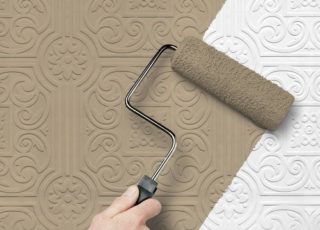
Wallpaper is not widely used in kitchens, since the wrong choice of material and adhesive composition quickly leads to flaking under the influence of moisture and temperature changes, which entails the need for repair.
For kitchens, choose exclusively washable wallpaper. Only vinyl can be used as the basis for the coating.
Among the advantages of the material, there are democratic prices for inexpensive interiors and unique solutions in a high price range. Special glue is bought for wallpaper.
Vinyl wallpaper is strong and tough enough to hide small surface irregularities.
It is better to choose vinyl wallpaper for painting - in this case, it is easy to change the annoying interior. Manufacturers in the characteristics of the product declare the possibility of 10-15 colors within 20 years of the coating service.
Ceiling tiles
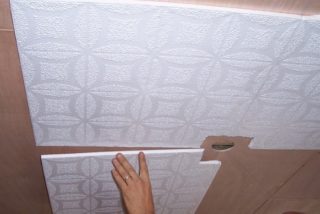
Facing the ceiling in the kitchen with polystyrene tiles is the cheapest finishing option.
- Polystyrene, suitable for the kitchen. It is lightweight, easy to install and clean, and is immune to moisture and temperature fluctuations.
- Polyvinyl chloride - waterproof, chemically resistant, available in various colors, with a symmetrical and chaotic pattern.
An additional advantage of the material is considered to be good sound insulation properties.
Polystyrene versions are made by pressing or extrusion - these are cheap porous products. Moisture penetrates into micropores, grease and dust are deposited.
For the kitchen, it is better to use sintered tiles, which make the surface smooth.
During installation, it is necessary to choose the right adhesive composition, then the tile will not fall off for many years. The panels are glued onto a flat primed surface. It is important that the height difference does not exceed 5 mm per meter of the length of the room.
The material easily hides the recesses, since the tile itself has dimensions from 15x15 to 30x30 cm.
Plasterboard sheets
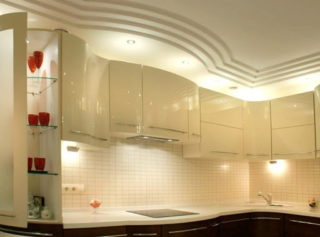
Plasterboard ceilings are arranged in rooms where "losing" 10-15 cm of height is not critical. Multi-level ceilings of complex shapes are made of plasterboard. The finished structure hides large irregularities, communications (pipes, exhaust ventilation ducts) from view. It is easy to install recessed lamps into the material.
The basis is a frame made of wooden blocks or galvanized metal profiles. Sheets of drywall are attached to the frame with self-tapping screws.
For a wooden frame, hardware is used with a large pitch, for metal - with a small one.
The class and purpose of drywall is judged by the marking:
- GKL - without additional properties, at humidity above 70% it begins to get wet and deformed, it is better not to use it for the kitchen;
- GKLO is fire-resistant, its price is higher than that of a conventional one, and its resistance to moisture is similar to that of GKL;
- GKVL - moisture resistant with antifungal additives, moisture resistance is provided by the introduction of silicone into the composition;
- GKLVO - fire and moisture resistant, best suited for finishing the ceiling in the kitchen with gas stoves that create a high temperature.
You don't need a lot of experience to work, but you will definitely need an assistant.
Stretch ceiling
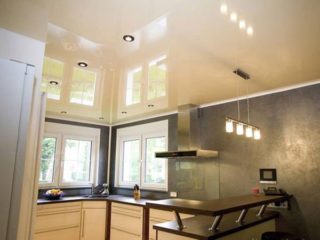
The material for the stretch ceiling films is polyvinyl chloride or fabric. For kitchens in houses and apartments, the first option is chosen. It does not absorb odors and is resistant to dirt deposits. Choose matte, glossy or satin texture of the film. The standard range includes about 200 shades of different colors. Optionally, order a photo printing of the picture you like or perforation.
Perforated film is not used in an intensively exploited kitchen - the holes become dirty quickly, the appearance cannot be restored by simple washing.
Installation takes no more than 1.5–2 hours, after which the ceiling is ready for use. Lighting is carried out with built-in lamps or classic chandeliers, for which holes are made in the canvas on site and mounting boxes and brackets of the required length are installed.
The minimum distance to the ceiling is 6–7 cm, which lowers the height of the kitchen.
The service life of PVC ceilings in a kitchen will be 8-10 years, after which it is enough to replace the canvas using the previously installed fastening profiles.
Panels made of various materials
Panel ceilings are second only to polystyrene tiles in ease of installation. One person can handle the job with a minimum of tools. The industry produces lining made of wood, plastic, metal.
Wooden lining

Coniferous wood products are not very suitable for kitchens. Even if they are treated with primers, regular temperature changes and high humidity lead to deterioration of the appearance. When the panel dries, gaps appear between the planks. When swelling, deformation occurs.
For lining, there is a great danger of flooding the ceiling of the kitchen in apartment buildings. The coating will have to be urgently dismantled for drying and re-installation.
It is better to sheathe the kitchen ceiling with expensive hardwoods, which will entail high costs. In addition, wooden ceilings are only compatible with the same walls. For apartments, this design option is rare.
The tree is a fire hazard.
For installation around the perimeter, wooden blocks are attached. The same timber is used for the manufacture of lathing. They are placed perpendicular to the direction of installation of the lining. The panels are nailed, self-tapping screws or clamps of the required size are used.
Plastic
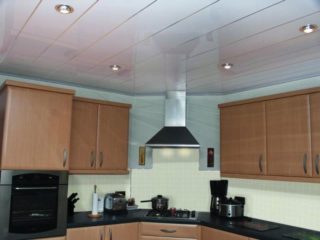
Plastic panels are durable, easy to clean and not subject to strong temperature deformation. Moisture is not absorbed into the material, and adhering dirt is easy to wash off. At the same time, part of the ceiling above the gas stove will be very hot, and low-quality panels may begin to deform. For protection, a screen is required, the functions of which can be performed by a gas or electric cooker hood.
It is not advisable to use white panels. Inexpensive products will gradually turn yellow from temperature.
Designers consider plastic to be an outdated material, but it is appropriate for repairs in small apartments.
The panels are fastened to the lathing made of wood or galvanized profiles. The second option is preferable, since it is less prone to deformation.
It is better to choose plastic panels that fit tightly to each other in the places of the lock - this way there will be fewer places for the accumulation of dust and grease.
Aluminum
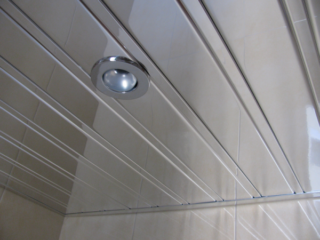
The aluminum rail is not afraid of moisture and temperature extremes. The products are easy to install and maintain.
Painted options are chosen for the kitchen - the mirror coating quickly becomes covered with stains and requires frequent cleaning.
Panels are of open and closed type. The second option is preferable for the kitchen, since it has smaller gaps where dirt can accumulate.
The disadvantages are considered to be the high price and a decrease in the ceiling level by at least 7 cm.
MDF
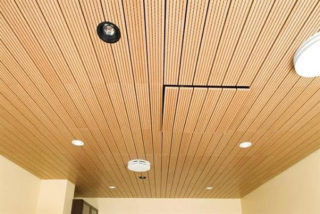
The panels are made by pressing wood chips under high pressure, the binder is urea resins.
MDF finish is not suitable for apartment buildings, where leaks from the upper floors often occur - the products are deformed, the coating peels off. Such panels cannot be repaired.
MDF is used in private houses with high ceilings, but possible flooding from the second floor must be taken into account.
Fasten MDF on a lathing made of wood or metal profile.
Non-standard solutions
For dining rooms in offices, it is possible to use unusual solutions, since intense vapors do not occur here.
Use:
- cassette ceilings of the Armstrong type;
- mirror tiles;
- glass.
The materials are easy to install and require minimal maintenance.
For finishing the ceiling in the kitchen, various options are applicable. The main thing when choosing materials is to assess the operating conditions and possible risks in the form of high temperatures and possible communal accidents. The correct choice of material and adherence to the installation technology is the key to the long operation of the ceiling.


